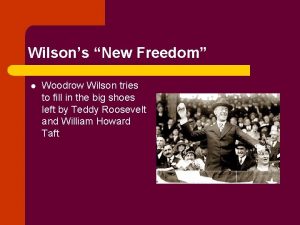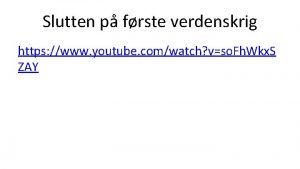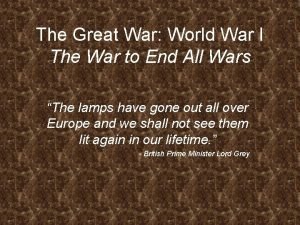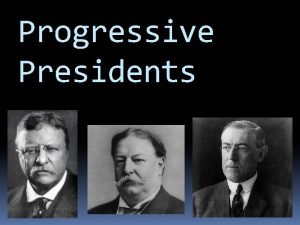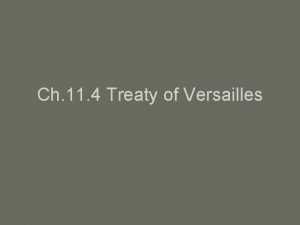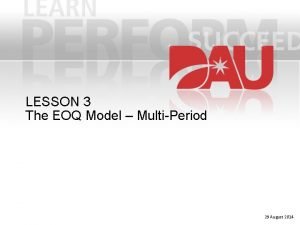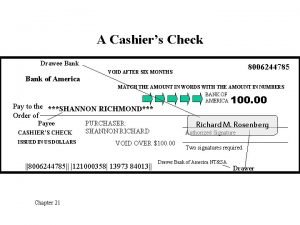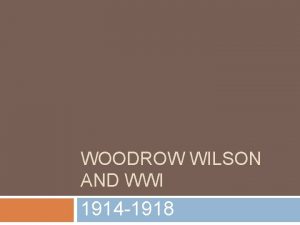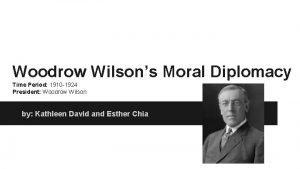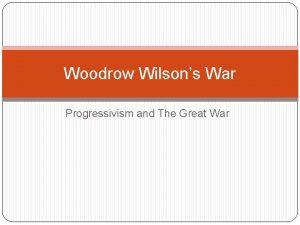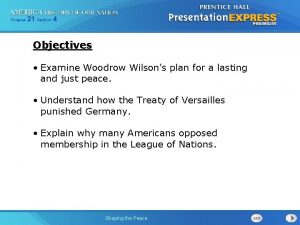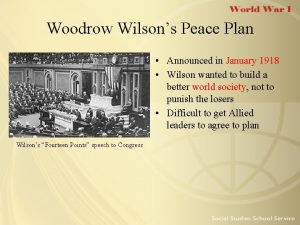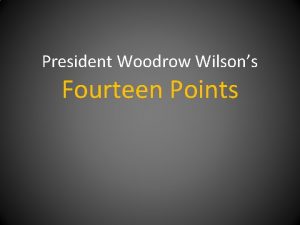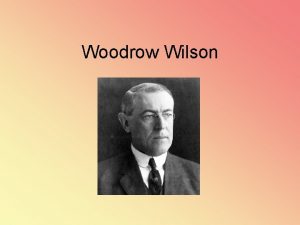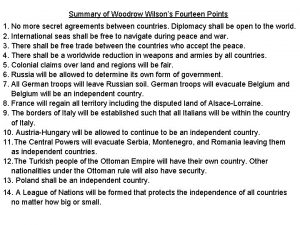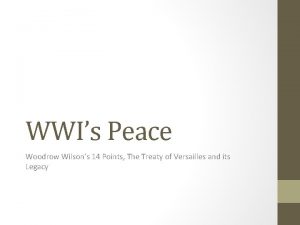Check for Understanding One of Woodrow Wilsons most
















- Slides: 16

Check for Understanding One of Woodrow Wilson’s most important goals after World War I was to establish a League of Nations. What was the main job of the League supposed to be? 1. Make it unnecessary for the United States to involve itself in international disputes 2. Provide a way for countries to resolve disputes between them without going to war 3. Maintain the world economic system so that colonies would no longer be necessary 4. Hold the nations of Europe responsible for the death and destruction of World War I. The main purpose of President Wilson’s Fourteen Points at the end of World War I was to 1. Assist the leaders of Europe to gain additional territory at Germany’s expense 2. Assure peace in the future by not treating Germany as a vanquished nation 3. Divide Germany into several parts so it would not be a threat in the future 4. Gain reparations from Germany to help pay for the cost of the war


Check for Understanding The establishment of the independent countries of Czechoslovakia, Hungary, and Yugoslavia was the result of (1) the Franco-Prussian War (2) the Berlin Conference (3) World War I (4) the Munich Pact The most significant difference between the Treaty of Versailles and Wilson’s Fourteen Points was 1. There was no clause ending unrestricted submarine warfare in the Treaty of Versailles 2. The League of Nations was not included in the Treaty of Versailles 3. Germany was severely punished and forced to pay reparations in the Treaty of Versailles 4. The Ottoman Empire was allowed to keep its territory in the Treaty of Versailles

Treaty of Versailles • Crucial Terms: § Clause 231: “War guilt” clause: § “The Allied and Associated Governments affirm and Germany accepts the responsibility of Germany and her allies for causing all the loss and damage to which the Allied and Associated Governments and their nationals have been subjected as a consequence of the war imposed upon them by the aggression of Germany and her allies. ” § Clause 232: reparations, eventually calculated at $33, 000, 000 (1921) § Covenant of the League of Nations

Post-WWI new nation-states

Check for Understanding Which statement best describes the relationship between WWI and the Russian Revolution? (1) WWI created conditions within Russia that helped trigger a revolution. (2) WWI postponed the Russian Revolution by restoring confidence in the Czar. (3) The Russian Revolution inspired the Russian people to win WWI. Adolf Hitler was aided in his rise to power by the (1) Economic problems of post-WWI Germany. (2) Support the Communist Party in Germany. (3) Support the French government. (4) Imperialist policy of the Weimar Republic.

Check for Understanding The situation shown in this 1919 cartoon is most directly associated with (1) efforts to stabilize the global economy (2) the removal of Lenin from power (3) widespread German victories (4) the aftermath of war

Check for Understanding The establishment of the independent countries of Czechoslovakia, Hungary, and Yugoslavia was the result of (1) the Franco-Prussian War (2) the Berlin Conference (3) World War I (4) the Munich Pact Which statement best describes the relationship between WWI and the Russian Revolution? (1) WWI created conditions within Russia that helped trigger a revolution. (2) WWI postponed the Russian Revolution by restoring confidence in the Czar. (3) The Russian Revolution inspired the Russian people to win WWI.

Check for Understanding In early 20 th-century Russia, which group may have gained support by circulating this poster? (1) aristocracy (2) monarchists (3) Bolsheviks (4) Orthodox clergy

Check for Understanding An incompetent government, massacres on Bloody Sunday, and the high costs of World War I were causes of the (1) Mexican Revolution (2) Boxer Rebellion (3) Sepoy Mutiny (4) Russian Revolution The Bolshevik Revolution 1917 was a major turning point in history because (1) Russia became the first nation with a communist economic system. (2) It was the last revolution in the 20 th century. (3) Russia ceased to be an important force in world affairs. (4) The royal family was exiled to Mexico.

Check for Understanding • Led the Russians in a second Revolution (1917) • Promised “Land, Peace, and Bread” • Established the New Economic Policy (NEP) Which leader is being described by these statements? (1) Czar Nicholas II (2) Mikhail Gorbachev (3) Vladimir I. Lenin (4) Nikkita Khrushchev Which action contributed to the success of Lenin’s communist revolution in Russia? (1) Peasants were promised land reform. (2) Businessmen were encouraged to form monopolies. (3) Landowners were offered tax relief. (4) Factory workers were required to start small businesses.

Check for Understanding • A characteristic of Vladimir I. Lenin’s New Economic Policy (NEP) was that it (1) Included elements of capitalism. (2) Nationalized all industries in Russia. (3) Expelled all foreign businesses in Russia. (4) Was a pure, communist economic system.

Check for Understanding Censorship, a one-party dictatorship, and the replacement of religious ideals with those of the state are all characteristics of a (1) democratic government (2) limited monarchy (3) totalitarian government (4) parliamentary system The primary purpose of Joseph Stalin’s five-year plans was to (1) increase agricultural and industrial output 2) limit the wealth of the upper class (3) increase the production of consumer goods (4) limit immigration of ethnic minorities

Check for Understanding Which statement best explains why democratic governments failed in many European nations after World War I? (1) The United States openly interfered in European political affairs. (2) These nations were constantly threatened by attacks from the victors of the war. (3) The working class were put in control of the industrial production in these nations. (4) The governments were unable to solve serious economic problems in these nations. In the 1920 s and 1930 s, the rise of totalitarian governments in Germany, Italy and Spain was largely the result of (1) Severe economic problems that arose after World War I (2) The success of the Communists in establishing a command economy in the Soviet Union. (3) The active support of the Unites States (4) Movements demanding the return of the old monarchies. Show of fingers!

Check for Understanding Show of fingers! One reason for the outbreak of World War II was the (1) ineffectiveness of the League of Nations (2) growing tension between the United States and the Soviet Union (3) conflict between the Hapsburg and the Romanov families (4) refusal of the German government to sign the Treaty of Versailles. In an effort to avoid a second “world war”, when did the Britain and France adopt a policy of appeasement toward Germany? (1) Before the war began. (2) When they declared war. (3) When the United States declared war. (4) After France was invaded and divided. WW 2 began when Germany invaded (1) Russia (2) Austria (3) Czechoslovakia (4) Poland

n Based on the information provided by the diagram, which statement is a valid conclusion about the 1930 s? (1)The United States led international peacekeeping efforts. (2) Aggression led to the start of World War II. (3) The actions of Italy, Germany, and Japan united Europe. (4) Economic and social upheaval led to the rise of democracy in Asia.
 Woodrow wilsons new freedom
Woodrow wilsons new freedom Woodrow wilsons 14 punkter
Woodrow wilsons 14 punkter Nationalism
Nationalism Woodrow wilson
Woodrow wilson Mouse control whitehouse
Mouse control whitehouse Wilsons fourteen points and the treaty of versailles
Wilsons fourteen points and the treaty of versailles Wilsons brøker
Wilsons brøker Formula of eoq
Formula of eoq Let's check your understanding
Let's check your understanding Behavior check in check out sheet
Behavior check in check out sheet Behavior check in check out sheet
Behavior check in check out sheet Check in check out
Check in check out Check in check out system
Check in check out system Cashier check
Cashier check Advantages and disadvantages of boundary fill algorithm
Advantages and disadvantages of boundary fill algorithm Check in check out intervention
Check in check out intervention Check in check out intervention
Check in check out intervention
